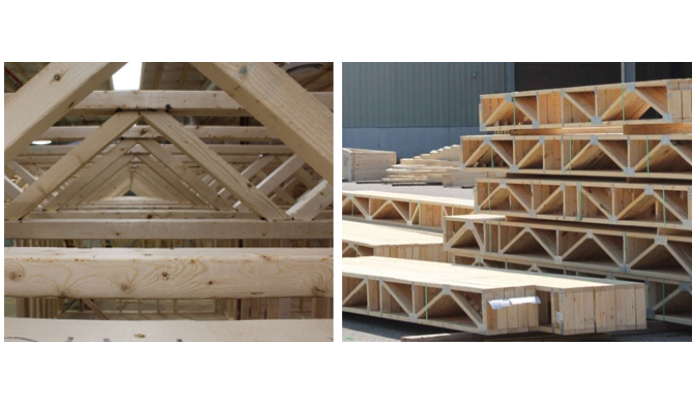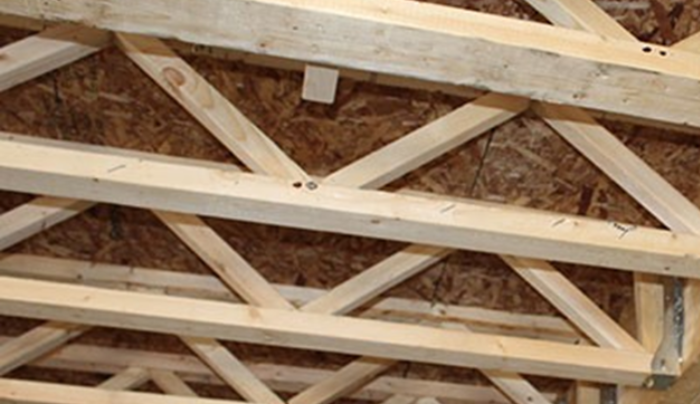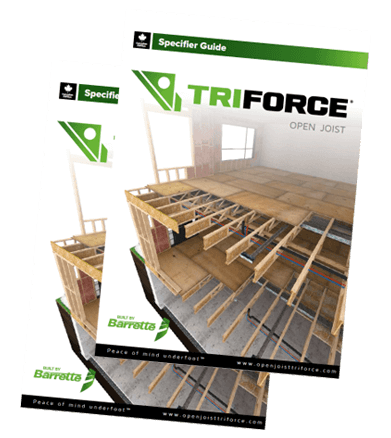Open joist TRIFORCE® and plated trusses are both open-web but in fact, there are several differences. These two engineered wood floor joists have many characteristics that distinguish them from one another. Let’s review the positive impact of using TRIFORCE®, a finger-jointed joist, in lieu of plated floor trusses:
- Fire-resistance
- Ecologic
- Less expensive
- No delays
- No corrosion
- No squeeking
- Light weight, less injuries and less material damage
Let’s take a look at each of these positive impacts in details:

1 – Fire-resistance:
With the addition of a layer of OSB, plywood or gypsum board to their trimmable end, TRIFORCE® joists are compliant to IRC requirements. The glue used on the finger-joints is a heat and fire resistant structural resorcinol glue. As for the plated trusses, they can be vulnerable to fire damage. When exposed to high temperatures, the metal plates that hold the truss together can weaken and fail, causing the truss to collapse.
To prevent fire damage to plated trusses, the installation of fire-resistant materials is required. For plated trusses to be IRC compliant, a membrane consisting of a 1/2-inch gypsum board or equivalent must be applied to the underside of the floor system. This will add time and cost to the project.
2 – Ecologic:
TRIFORCE® adhesive cures naturally without the need for infrared or other curing processes. In addition, no steel plate connectors are used, avoiding energy use expended in the steel making process. Because of its open-web configuration, wood fiber conservation and absence of steel plates, TRIFORCE® is lightweight so fuel usage is minimized when transporting the product.

3 – Less expensive:
Steel costs have risen in recent years. Being the means of connection, steel plates are a major cost contributor in the manufacturing of plated trusses. This cost doesn’t exist with TRIFORCE®.
Lineal foot labor cost for TRIFORCE® is much less than that for traditional trusses. because TRIFORCE® joists are assembled robotically in a state-of-the-art manufacturing facility. In a given period of time, more TRIFORCE® joists can be produced by fewer people than is possible with plated floor trusses.
Without steel plates and surplus wood fiber, TRIFORCE® joists weigh as much as 25% less than plated trusses of the same size. This allows for more joists shipped on a truck and a lower freight cost per lineal foot of component.
4 – No delays:
Plated trusses are more likely to have delays. They are manufactured to specific lengths and cannot be trimmed on site. They also require an engineer to modify them. When production is at its peak, material shortages may be a factor. There is no wait for TRIFORCE® joists because they are mass produced and in stock at many locations.
5 – No corrosion:
Plated floor trusses are trusses that have been reinforced with additional metal plates to increase their strength. But when metal is exposed to the environment, a natural process called corrosion occurs. It can weaken the structural integrity of metal components, including trusses. TRIFORCE® joists are manufactured of all wood components resulting in superior strength from the glued finger-joints and triangular design.
6 – No squeeking:
TRIFORCE® open joists’ all wood construction and glued joints eliminate the potential for squeaking. Plated floor trusses can squeak due to potential metal-to-metal contact between the joists, hangers and fastening hardware.

7 – TRIFORCE®: light weight, less injuries and less material damage
Plated trusses are heavy and more difficult to handle, most of the time requiring two people to carry them. As for TRIFORCE® open joists, their light weight due to efficient use of wood fiber and no metal nail plates, a single person usually carry them. In these times of labor shortages, this can mean a lot!
TRIFORCE® open joists are safer for framers to handle. The very sharp exposed edges of the metal plates on plated floor trusses can cause serious injuries!
In addition, the metal connector plates used in this type of engineered wood joist are sharp and can cause damage to other materials such as electrical wiring and can hinder the installation of plumbing and mechanical systems. When MEP systems are installed in a TRIFORCE® floor, there is no concern about wires or ductwork getting hung up on the metal plates.
In summary, we can say that an engineered wood floor system using TRIFORCE® open joists is much more advantageous. If you want to learn more, please download our spec guide:
